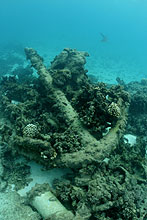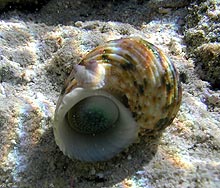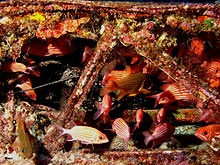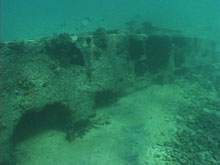NOWRAMP
2002
Marine
Life Ecology & Shipwrecks in the Northwestern Hawaiian
Islands: Artificial Reef Structures and Marine Animal Utilization
Posted by Marc Hughes, UH Hilo Biology and Marine Science
student
 Maritime
archaeology and marine ecology may initially seem to be
very disconnected fields of study. Habitation of marine
life on wrecks and their utilization of wreckage serves
as a connecting tie between these two disciplines. Communities
of marine life associated with wreckage caused by ship disasters
offer a unique look at the ecology of organisms associated
with an unusual anthropogenic habitat. Observations of marine
animals around shipwrecks reveal interesting patterns of
ecology and often go unnoticed by biologists that strictly
focus on natural reef systems. Similar trophic dynamics
and predator evasion techniques that rule the lives of marine
animals on natural substrate types are often evident around
shipwrecks and their associated wreckage. The three dimensional
habitat that is produced by shipwrecks provides a multitude
of organisms with refuge, attachment sites, and hunting
habitat. The shipwrecks in the Northwestern Hawaiian Islands
offer a distinctive look at how marine organisms presently
take advantage of temporal, artificial reef structures associated
with the misfortune swept upon many sailors throughout history.
Maritime
archaeology and marine ecology may initially seem to be
very disconnected fields of study. Habitation of marine
life on wrecks and their utilization of wreckage serves
as a connecting tie between these two disciplines. Communities
of marine life associated with wreckage caused by ship disasters
offer a unique look at the ecology of organisms associated
with an unusual anthropogenic habitat. Observations of marine
animals around shipwrecks reveal interesting patterns of
ecology and often go unnoticed by biologists that strictly
focus on natural reef systems. Similar trophic dynamics
and predator evasion techniques that rule the lives of marine
animals on natural substrate types are often evident around
shipwrecks and their associated wreckage. The three dimensional
habitat that is produced by shipwrecks provides a multitude
of organisms with refuge, attachment sites, and hunting
habitat. The shipwrecks in the Northwestern Hawaiian Islands
offer a distinctive look at how marine organisms presently
take advantage of temporal, artificial reef structures associated
with the misfortune swept upon many sailors throughout history.
The
techniques we used to explore the wrecks were dependent
upon the depth of the shipwreck. We mostly used snorkel
gear at sites that were less than 2 meters deep. At sites
exceeding that depth we used Scuba diving apparatus. Two
team members of the maritime archaeological team (Dr. Hans
Van Tilburg and graduate student Suzanne Finney) would photograph
the structure, record measurements and take bearings of
the wreck. The third member (myself) would collect algae
samples, photograph, and record the types and activities
of obvious marine life species inhabiting the areas in close
proximity to the wrecks.
 Shipwrecks
in this area of the Hawaiian archipelago leave behind several
different types of wreckage that are utilized by marine
organisms. The types of wreckage that were encountered on
our examinations of the shipwrecks were large sections of
relatively intact hull, scattered shards of metal, and anchors
and chains. Shipwrecks that occurred within the last 50
to 70 years left behind relatively large sections of metal
hull. Older wrecks, having been made mostly of wood, left
behind anchors, chains, integral metal machinery, and copper
based fastening pins. Wood from older ships is broken down
by both decomposition and physical processes (storm generated
swells) and therefore do not contribute significantly to
wreckage on a long term basis. Species composition of the
fauna seemed dependent upon the size of the cover offered
by such pieces of wreckage. Large sections of hull were
often utilized by crustaceans, schools of medium sized reef
fish, large predatory fish, and even monk seals. Solitary
anchors, although sometimes very large, were mostly used
by smaller reef fish and mollusks.
Shipwrecks
in this area of the Hawaiian archipelago leave behind several
different types of wreckage that are utilized by marine
organisms. The types of wreckage that were encountered on
our examinations of the shipwrecks were large sections of
relatively intact hull, scattered shards of metal, and anchors
and chains. Shipwrecks that occurred within the last 50
to 70 years left behind relatively large sections of metal
hull. Older wrecks, having been made mostly of wood, left
behind anchors, chains, integral metal machinery, and copper
based fastening pins. Wood from older ships is broken down
by both decomposition and physical processes (storm generated
swells) and therefore do not contribute significantly to
wreckage on a long term basis. Species composition of the
fauna seemed dependent upon the size of the cover offered
by such pieces of wreckage. Large sections of hull were
often utilized by crustaceans, schools of medium sized reef
fish, large predatory fish, and even monk seals. Solitary
anchors, although sometimes very large, were mostly used
by smaller reef fish and mollusks.
A
large military landing craft submerged next to Tern Island
in the French Frigate Shoals had 5 sleeping whitetip reef
sharks Trianodon obesus, resting in a cavity created
by the overturned craft. The channel through the reef where
the landing craft is located is known to be patrolled by
tiger sharks Galeocerdo cuvieri  during
albatross fledgling season (Wegmann, personal communication).
The sandy area prevalent around the landing craft offered
no such resting or hiding place for the sharks to take refuge,
in the event a hungry tiger shark were to focus its attention
on the vulnerable White-tip reef sharks.
during
albatross fledgling season (Wegmann, personal communication).
The sandy area prevalent around the landing craft offered
no such resting or hiding place for the sharks to take refuge,
in the event a hungry tiger shark were to focus its attention
on the vulnerable White-tip reef sharks.
Two
large anchors were stuck in the reef in the same channel.
The protruding posts from these anchors were being used
as resting places by boobies. Since thousands of nesting
birds are present on the island at any given time, resting
areas are at a premium which is evident by the raucous squawking
of bickering neighbors.
 Five
anchors are located near the landing at Laysan island. All
five were submerged, and partially buried by sand. An endemic
snail is found in high densities either directly on or within
a few centimeters of the metal structure. The Hawaiian Turban
(Turbo sandwicensis) is a soft bodied snail that
lives in a protective shell 6 cm in length. The aperture
of opening of the shell is plugged by a protective operculum
or round calcareous cover when it is inactive or feels threatened.
The colorful operculum is green, brown, orange and white
and it is often referred to as a "cat's eye" by
shell collectors. The operculum is not always reliable in
dissuading hungry predators. Numerous locations in the sand
flats belied this fact as broken up shells were strewn across
the revealing marine habitat. The shell is well camouflaged
by blotches of coralline algae on its apex or tip and it
blends in well in the algae covering the anchors. They were
found in shaded areas where right angles were created by
the fluke arms and the shanks of the anchors. Many intact,
old shells and operculums were found buried in the sand
below the anchors indicating possible long-term use of the
anchors by T. sanwichensis.
Five
anchors are located near the landing at Laysan island. All
five were submerged, and partially buried by sand. An endemic
snail is found in high densities either directly on or within
a few centimeters of the metal structure. The Hawaiian Turban
(Turbo sandwicensis) is a soft bodied snail that
lives in a protective shell 6 cm in length. The aperture
of opening of the shell is plugged by a protective operculum
or round calcareous cover when it is inactive or feels threatened.
The colorful operculum is green, brown, orange and white
and it is often referred to as a "cat's eye" by
shell collectors. The operculum is not always reliable in
dissuading hungry predators. Numerous locations in the sand
flats belied this fact as broken up shells were strewn across
the revealing marine habitat. The shell is well camouflaged
by blotches of coralline algae on its apex or tip and it
blends in well in the algae covering the anchors. They were
found in shaded areas where right angles were created by
the fluke arms and the shanks of the anchors. Many intact,
old shells and operculums were found buried in the sand
below the anchors indicating possible long-term use of the
anchors by T. sanwichensis.
A
shy reef fish, the fantail filefish (Pervagor spilisoma),
was found at 4 out of 5 of the anchors. It is very wary
species and would seek refuge in any crevice created by
the anchors contact with the substrate when approached and
photographed. The anchors seem to provide refuge in a habitat,
sand and rubble flats, which would be inhospitable to both
T. sandwichensis and P. spilisoma due to the
conspicuousness and the high level of predation in these
areas.
 The
S.S. Quartette, a ship which grounded in 1952, left
a trail of large metal hull and machinery scraps littered
on the inside of the shallow reef at Pearl and Hermes Atoll.
Numerous species of wrasses including the blacktail wrasse
(Thallasoma ballieui) and terminal lined Coris (Coris
ballieui) were seen foraging around the wreckage and
swimming under and through the spaces under the metal. Two
species of fish congregated in relatively large numbers
around the wreck and seemed to use the protective areas
under the larger metal pieces for refuge. Both the yellowfin
goatfish (Mulloidichthys vanicolensis) and the spotfin
squirrelfish (Neoniphon samara) were seen fleeing
quickly to protected areas of the wreckage when a patrolling
squad of predatory giant trevallies (Carynx ignobilis)
made lunging bolts towards the schools of vulnerable reef
fish. One of the largest species of hermit crabs that sought
refuge in the smaller inaccessible recesses of the wreckage
is the white spotted hermit crabs (Dardanus megistos).
This crab usually relies on the protection of empty shells
from the tritons trumpet (Charonia tritonis) or black-lipped
tun (Tonna melanostoma). Instead of a calcareous
operculum these hermit crabs use their left claw (cheliped)
as a plug to block the opening of the shell. These crustaceans
are vulnerable to more pernicious predators and their shells
are not invincible. Therefore, by hiding in the hard to
get at sections of the metal wreckage they effectively use
a "shell within a shell" defense technique.
The
S.S. Quartette, a ship which grounded in 1952, left
a trail of large metal hull and machinery scraps littered
on the inside of the shallow reef at Pearl and Hermes Atoll.
Numerous species of wrasses including the blacktail wrasse
(Thallasoma ballieui) and terminal lined Coris (Coris
ballieui) were seen foraging around the wreckage and
swimming under and through the spaces under the metal. Two
species of fish congregated in relatively large numbers
around the wreck and seemed to use the protective areas
under the larger metal pieces for refuge. Both the yellowfin
goatfish (Mulloidichthys vanicolensis) and the spotfin
squirrelfish (Neoniphon samara) were seen fleeing
quickly to protected areas of the wreckage when a patrolling
squad of predatory giant trevallies (Carynx ignobilis)
made lunging bolts towards the schools of vulnerable reef
fish. One of the largest species of hermit crabs that sought
refuge in the smaller inaccessible recesses of the wreckage
is the white spotted hermit crabs (Dardanus megistos).
This crab usually relies on the protection of empty shells
from the tritons trumpet (Charonia tritonis) or black-lipped
tun (Tonna melanostoma). Instead of a calcareous
operculum these hermit crabs use their left claw (cheliped)
as a plug to block the opening of the shell. These crustaceans
are vulnerable to more pernicious predators and their shells
are not invincible. Therefore, by hiding in the hard to
get at sections of the metal wreckage they effectively use
a "shell within a shell" defense technique.
 A
sunken submarine rescue vessel, the U.S.S. Macaw,
at Midway Atoll was a congregating site for many reef fish
and is patrolled by Galapagos sharks (Carcharhinus galapagensis).
The bow section of the vessel provides a safe spot for a
cleaning station at which several morwongs (Cheilodactylus
vittatus) were being picked clean of ectoparasites by
Hawaiian cleaner Wrasse (Labroides pthirophagous).
A thorough inspection of the shaded areas of the wreck revealed
titan scorpionfish (Scorpaenopsis cacopsis) lying
in wait for prey that were looking for good hiding spots
under the wreckage.
A
sunken submarine rescue vessel, the U.S.S. Macaw,
at Midway Atoll was a congregating site for many reef fish
and is patrolled by Galapagos sharks (Carcharhinus galapagensis).
The bow section of the vessel provides a safe spot for a
cleaning station at which several morwongs (Cheilodactylus
vittatus) were being picked clean of ectoparasites by
Hawaiian cleaner Wrasse (Labroides pthirophagous).
A thorough inspection of the shaded areas of the wreck revealed
titan scorpionfish (Scorpaenopsis cacopsis) lying
in wait for prey that were looking for good hiding spots
under the wreckage.
 A
corsair plane located on Midway atoll, at about 40 meters
deep, had Hawaiian squirrelfish (Sargocentron xantherythrum),
spotted cardinalfish (Apogon maculiferus), and Japanese
angelfish (Centropyga interrupta) seeking cover in
holes created by missing skin on the outside of the aircrafts
framework. A predatory species of scorpionfish, Rhinopias
xenops, was found congregating (7 individuals) on the
exterior of the wreck. The scorpionfishs cryptic camouflage
and motionless hunting technique produces an effective trap
for smaller fish looking for shelter.
A
corsair plane located on Midway atoll, at about 40 meters
deep, had Hawaiian squirrelfish (Sargocentron xantherythrum),
spotted cardinalfish (Apogon maculiferus), and Japanese
angelfish (Centropyga interrupta) seeking cover in
holes created by missing skin on the outside of the aircrafts
framework. A predatory species of scorpionfish, Rhinopias
xenops, was found congregating (7 individuals) on the
exterior of the wreck. The scorpionfishs cryptic camouflage
and motionless hunting technique produces an effective trap
for smaller fish looking for shelter.
Kure
Atoll had numerous large sections of intact hull of fishing
vessels and one particularly large wreck, the Houei Maru
(Van Tillburg, personal communication). Several of these
sections were still emergent through the waters surface
and were being used by black noddies (Anous minutus)
and masked boobies (Sula dactylatra) as perching
sites. Two sections of the Houei Maru were found
at a great distance from each other, one being just inside
the reef and the other much farther inside the lagoon. The
section just inside the reef seemed to be used by 3 Hawaiian
monk seals (Monachus schauinslandi) as a central
base for forays. This could be a significant place for these
animals to seek refuge, as it is located quite a distance
from the nearest beach where they would normally seek refuge.
These animals usually hunt far from shore and predation
by sharks is not uncommon as is evident by shark bite wounds
and scars on seals found on the beach. The section of the
wreck found farther inside the lagoon was found to be inhabited
by lizardfish (Synodus sp.) and spotfin squirrelfish.
Two 20 cm long lizardfish were buried in soft sediment under
a large section of metal that created a dark hiding spot.
Lizard fish hunt by darting up from the bottom and snatching
smaller reef fish with lightning fast speed (ambush predators).
Fish that try to evade predators by entering the wreck would
literally swim "out of the pan and into the fire."
 It
seems that a variety of marine organisms utilize the shipwrecks
for several different purposes. Many species of both fish
and invertebrates use the wreckage material to evade predators
and as a safe resting place. Some species of predators use
the shipwrecks as hunting areas either as residents hiding
in the wreckage or patrolling predators that use the wrecks
as a fish aggregating device (FAD). Symbiotic cleaning organisms
(Hawaiian cleaner wrasse) which normally "set up shop"
at prominent coral heads or outcroppings may utilize artificial
coral heads (ship wreckage) to attract fish looking for
cleaning stations to have their ectoparasites removed. Ecological
patterns that are evident around shipwrecks seem to imitate
natural reef dynamics on a smaller scale. Long term investigations
into the intricacies of marine organism interactions at
shipwrecks would reveal numerous other ecologically significant
activities. Shipwrecks act as natural laboratories in which
biologists can study aspects such as succession and species
composition changes, trophic webs, and symbiosis. Interdisciplinary
cooperation in methods of locating shipwrecks and studying
both the flora and fauna at these sites is a completely
new idea. Research cruises like NOWRAMP 2002 in the Northwestern
Hawaiian Islands is responding to the need for interdisciplinary
cooperation in these fields and providing insightful new
information about marine biology and maritime archaeology.
It
seems that a variety of marine organisms utilize the shipwrecks
for several different purposes. Many species of both fish
and invertebrates use the wreckage material to evade predators
and as a safe resting place. Some species of predators use
the shipwrecks as hunting areas either as residents hiding
in the wreckage or patrolling predators that use the wrecks
as a fish aggregating device (FAD). Symbiotic cleaning organisms
(Hawaiian cleaner wrasse) which normally "set up shop"
at prominent coral heads or outcroppings may utilize artificial
coral heads (ship wreckage) to attract fish looking for
cleaning stations to have their ectoparasites removed. Ecological
patterns that are evident around shipwrecks seem to imitate
natural reef dynamics on a smaller scale. Long term investigations
into the intricacies of marine organism interactions at
shipwrecks would reveal numerous other ecologically significant
activities. Shipwrecks act as natural laboratories in which
biologists can study aspects such as succession and species
composition changes, trophic webs, and symbiosis. Interdisciplinary
cooperation in methods of locating shipwrecks and studying
both the flora and fauna at these sites is a completely
new idea. Research cruises like NOWRAMP 2002 in the Northwestern
Hawaiian Islands is responding to the need for interdisciplinary
cooperation in these fields and providing insightful new
information about marine biology and maritime archaeology.
References:
Dr. Hans Van Tilburg, Maritime Archaeology and History Team
Leader
Alex
Wegmann, Field Biologist, U.S. Fish and Wildlife Service
 Talk About It!
Talk About It!
Asked by glenn from clark design on Sep 27, 2003.
Please ask Marc Hughes to email me - I'm an old friend from UNY - urgent
Answered by Andy from NOAA on Oct 14, 2003.
Linking Archeology & Benthic Ecology Fields
Asked by claire from Wessex Archaeology on Nov 16, 2007.
I am currently working on a research study linking the disciplines of marine archaeology and benthic ecology to determine whether wreck ecology can be used as a proxy in assessing wreck site condition. In addition we are trying to evalute whether wreck sites with enforced exclusion zones act as refugia by in areas subject to marine aggregate extraction. I am currently carrying out a literature search to find out what work has already been done in this area and found some information on your website. Do you have any advice on good literature sources linking archaeological and ecological studies of wreck sites? Many Thanks.
Answered by Dr. Hans Van Tilburg, Maritime Heritage Coord., NOAA on Nov 24, 2007.
That is a very interesting and timely question. I have done some looking into sources in this area, and must say that I have not been able to find very many items linking the two fields (yet!). I included a brief report by biologist Marc Hughes ("Marine Life Ecology and Shipwrecks in the Northwestern Hawaiian Islands: Artificial Reef Structures and Marine Animal Utilization") in the summary of our 2002 field work in the NWHI (should be available from the Monument). And I also included another report by Michelle Calhoun and Anthony Pico ("The Kaua`i, a financial loss...an ecological gain: biological survey and mapping of the shipwreck Kaua`i, Mahukona, Hawai`i") in the summary of surveys done for the University of Hawaii back in 1997 (should be available from the University of Hawaii's Marine Option Program). I can tell you that many of the more extensive wreck sites seem to have an abundance of marine life associated with the locations, finding suitable substrate and living places in all the holes and crevices. There is also some related work done by Jim Maragos for the US Fish and Wildlife Service which features some long term interactions between the wreck and the immediate environment ("Preassessment Screen for Physical Injuries caused by the F/V Jin Shiang Fa Grounding at Rose Atoll National Wildlife Refuge 1996; Reef and Coral Observations on the Impact of the Grounding of the Longliner Jin Shiang Fa at Rose Atoll, American Samoa 1994; Monitoring and Partial Cleanup at Rose Atoll National Wildlife Refuge after a shipwreck). Additionally, I would suspect that monitoring assessments of shipwrecks sunk as artificial reefs would have some applicable data, but I have not looked into that. Best of luck to you, and I would be very interested in what you find out regarding this topic.